A latin-beat soundie, The Gay Ranchero (1941) is lively with streamers hanging from the ceiling & major party atmosphere packed with energetic dancers. Malina Luba was a singing star of the musical stage, nite clubs, & early television variety shows.
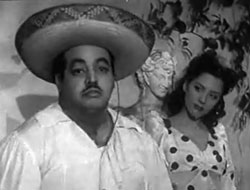 She had few screen credits, but appeared in Mexican Hayride (1948) in a role she first played on Broadway. She's the voluptuous crook Dagmar Marshak, leading lady to Lou Costello. She had few screen credits, but appeared in Mexican Hayride (1948) in a role she first played on Broadway. She's the voluptuous crook Dagmar Marshak, leading lady to Lou Costello.
In the soundies Cuban Pete (1942), Minnie From Trinidad (1942) & A Gay Ranchero, Luba was typecast as the Latina singer, & her name was mispelled "Molina" instead of Malina on title cards.
She was actually Russian by birth, not Mexican. She came to America as a child, & grew up in Greenwich Village. Her earliest stage experience was as part of Anna Pavlova's children's ballet.
In The Gay Ranchero, Luba rhumbas & sings of her love of Poncho, her big unfaithful sweetheart. There is an archly stereotyped Mexican back-up band plus the dancers all playing Mexicans as only kitsch entertainment could imagine them. Yet the band is the authentic Cuban beat Noro Morales & His Orchestra.
This soundie drums up a thin skeleton of a "story" during the song, in that the beautiful singer's fat boyfriend is cheating on her & she drags him away from the rival girl for a hug-dance. The absurd Pancho is played by Noro Morales himself.
In the last third of the soundie, we get more awful stereotyping of what it's like being married to a fat guy like Pancho. They live in poverty, she doing all the laundry, he in a perpetual siesta under his sombrero.
Despite the man's apparent worthlessness, the wife sings the lyrics, "I am so happy by his side," since lazy Mexican husbands are the ideal. However, he had enough energy in him to sire an enormous brood of children.
The Gay Ranchero was included on the one-reel home-movie Latin Novelties (1946) together with Gracie Barrie singing Stone Cold Dead in the Market (1946) & the Terry Twins singing Chiquita Banana (1946). There was also an Official Films home movie reel with Cuban Pete paired with The Havana-Madrid Show: Paran-Pan-Pan (1941), distributed incongrously under the title Hollywood Funtime! (1947).
Mexican Jumping Beans (1942) with "Noro Morales & His Rhumba Band" is included in the three-soundie Official Films one-reeler Rhumba Rhumba (1946) along with the De Castro Sisters' Pumpa Pumpa (1945) & the Dinning sisters' No Can Do (1945).
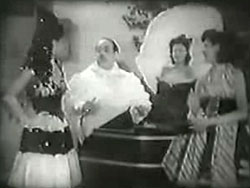 The camera opens on Noro Morales at the piano. The setting for Mexican Jumping Bean (1942) is a small Latino club. Two rhumba couples are dancing rapidly & the orchestra is dressed as if for a cartoon version of a Mexican fiesta. The conga drum keeps a swift beat. The camera opens on Noro Morales at the piano. The setting for Mexican Jumping Bean (1942) is a small Latino club. Two rhumba couples are dancing rapidly & the orchestra is dressed as if for a cartoon version of a Mexican fiesta. The conga drum keeps a swift beat.
It's soon obvious that two of the four dancers are the real stars of Mexican Jumping Bean. They're "Nino & Lenora," who also appear in the Wynn Murray soundie Blow, Gabriel, Blow (1942) & Noro Morales' Ella (1942).
To say they can dance is to say babies drink milk. They add a unique rhumba move in that they take turns dancing on one leg only, the other leg wrapped around their partner.
Jump-cut to a scene at the bar. A comedian dressed like the Cisco Kid is clapping drunkenly & laughing at the dancers. Jump-cut back to Nino & Lenora whirling up a storm.
Eventually Noro stands up from his piano & sings in Spanish to the three senoritas arrayed about the piano. For such a large man he has a high voice. It's a lively number, quite good despite the inherent campiness of the soundie & its stereotypical title.
A chorus line cha chas & Lenora bursts through the line to do her spectacular rhumba. Meanwhile at the bar the happy drunk is trying to tidy himself up apparently intending to hit on Lenora, though it's not certain what he's up to.
A white couple are also at the bar & the guy stands up to aggressively confront the silly little man for being a nuisance. The drunk takes off his Cisco jacket as if to fight, but when he turns around he sees the white guy is holding the jacket as if to help him put it on, so he puts it on.
Noro Morales is seated at his piano to one side of his orchestra. The camera pans, revealing to his otherside Luba Malina in a founcy Mexican costume, making vaguely rhumba motions with her arms as she sings the title number of the soundie Cuban Pete (1942).
This soundie can be found on the compilation disc The Swing Years: Elmer's Tune (2004) wrongly ascribed to Marie Caruso, who did do a soundie for this number two years later.
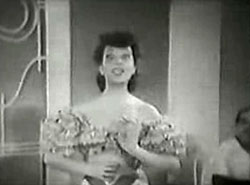 The Cuban Pete soundie was included in the Official Films home-movie reel Cuban Rhythms (1946) together with Jeri Sullavan's Rum & Coca Cola (1945) & Wini Shaw's The Nautch Girl from Cuba (1941). The Cuban Pete soundie was included in the Official Films home-movie reel Cuban Rhythms (1946) together with Jeri Sullavan's Rum & Coca Cola (1945) & Wini Shaw's The Nautch Girl from Cuba (1941).
The English language song was written by English bandleader Jose Norman, who despite his stage name had not a drop of Spanish or Latino blood in him, though he was married to the daughter of Cuban Council in Liverpoo, & he introduced the rhumba into England in 1933.
This song about a great Cuban dancer became de rigour for all the Latin bands in the US at the time, including Tito Puentes, Xavier Cugat, & most famously by Desi Arnaz, as well as by such non-Latinos as Louis Armstrong,
Luba's vocal rendition is neither the best nor worst, though presented more for the comedy of the piece than for its rhythm. She flirts shamelessly Noro as she sings. We cut away to the orchestra to see one of the band members with maracas dancing the role of Cuban Pete for the lyric, "When he plays his maracas he goes chik chikky boom chik chikky boom."
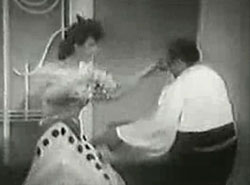 A choras line of girls comes at the camera in two rows & when they've passed to either side of the camera, one girl becomes the dance star of the soundie. A choras line of girls comes at the camera in two rows & when they've passed to either side of the camera, one girl becomes the dance star of the soundie.
She's Puerto Rican actress & dancer Marquita Rivera. She does a decent enough rhumba with perhaps a bit too much burlesque to it, while her male dance partner shakes & runs about like a crazed rooster.
The unknkown male dancer is only present to make Marquita look good, but a couple moves are his obviously attempts to get a bit of the attention for himself.
Near the end, Noro gets up from his piano bench & joins Luba in the rhumba until Luba closes the number with some outrageous mugging at the camera.
All very lively & fun, but one wonders how much or how little input Noro was permitted in any of his soundies, which promote Mexican stereotypes of the campiest sort. His usual stage presentation of himself & his band included well-taylored suits & ties.
Noro was one of the most influential Latin bands in New York beginning in the 1930s when his was the house band of El Morocco. In the '40s & early '50s, there was no more popular band in the city.
copyright © by Paghat the Ratgirl
|
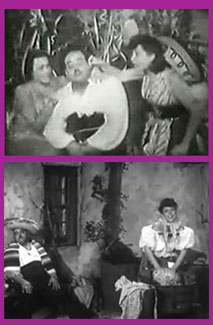
 She had few screen credits, but appeared in Mexican Hayride (1948) in a role she first played on Broadway. She's the voluptuous crook Dagmar Marshak, leading lady to Lou Costello.
She had few screen credits, but appeared in Mexican Hayride (1948) in a role she first played on Broadway. She's the voluptuous crook Dagmar Marshak, leading lady to Lou Costello. The camera opens on Noro Morales at the piano. The setting for Mexican Jumping Bean (1942) is a small Latino club. Two rhumba couples are dancing rapidly & the orchestra is dressed as if for a cartoon version of a Mexican fiesta. The conga drum keeps a swift beat.
The camera opens on Noro Morales at the piano. The setting for Mexican Jumping Bean (1942) is a small Latino club. Two rhumba couples are dancing rapidly & the orchestra is dressed as if for a cartoon version of a Mexican fiesta. The conga drum keeps a swift beat. The Cuban Pete soundie was included in the Official Films home-movie reel Cuban Rhythms (1946) together with Jeri Sullavan's Rum & Coca Cola (1945) & Wini Shaw's The Nautch Girl from Cuba (1941).
The Cuban Pete soundie was included in the Official Films home-movie reel Cuban Rhythms (1946) together with Jeri Sullavan's Rum & Coca Cola (1945) & Wini Shaw's The Nautch Girl from Cuba (1941). A choras line of girls comes at the camera in two rows & when they've passed to either side of the camera, one girl becomes the dance star of the soundie.
A choras line of girls comes at the camera in two rows & when they've passed to either side of the camera, one girl becomes the dance star of the soundie.